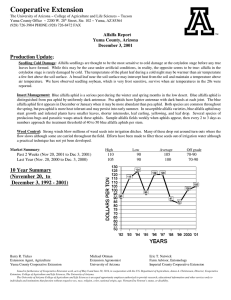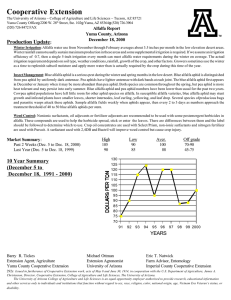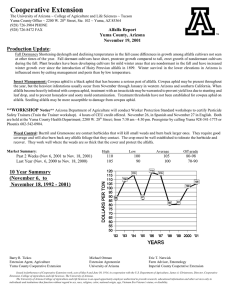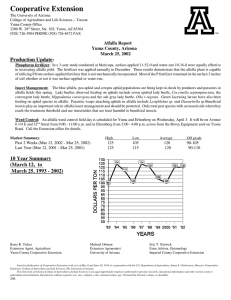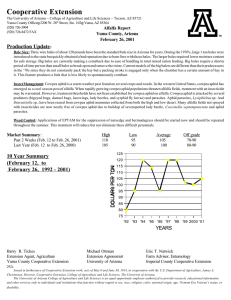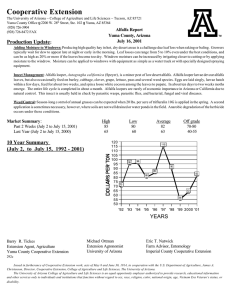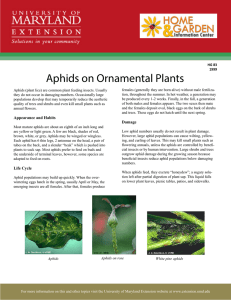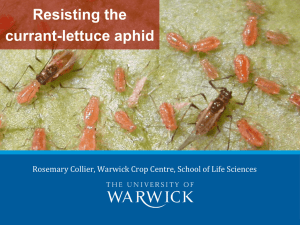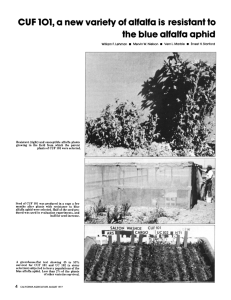Alfalfa Report: Yuma County Production Update (2001)
advertisement
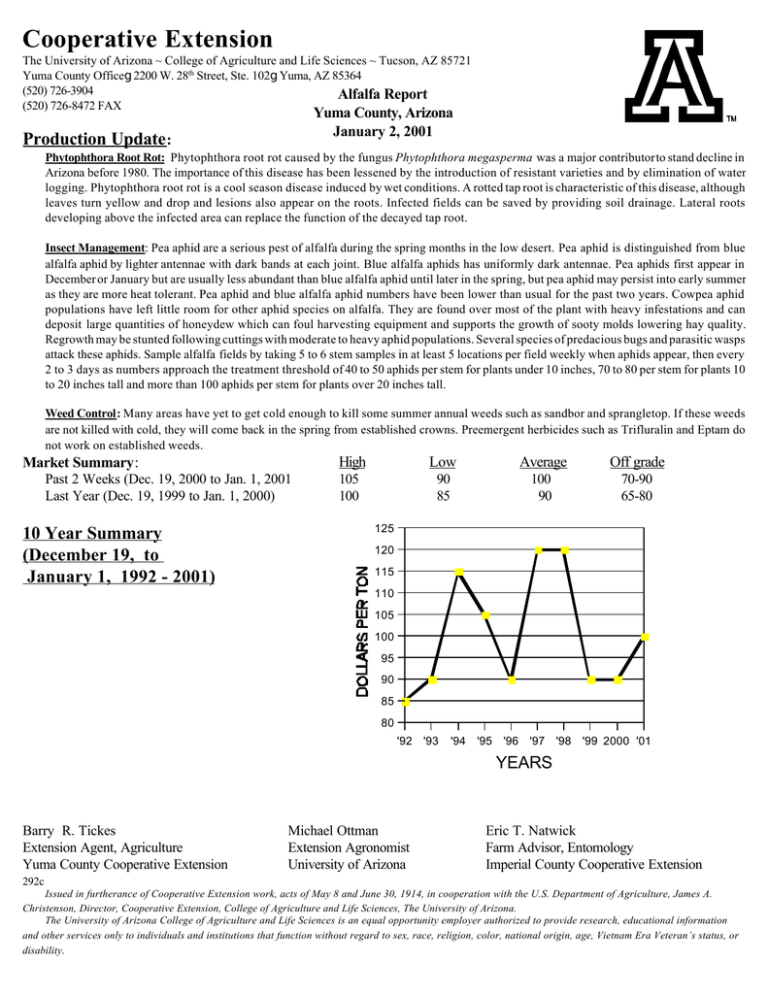
Cooperative Extension The University of Arizona ~ College of Agriculture and Life Sciences ~ Tucson, AZ 85721 Yuma County Officeg2200 W. 28th Street, Ste. 102gYuma, AZ 85364 (520) 726-3904 Alfalfa Report (520) 726-8472 FAX Yuma County, Arizona January 2, 2001 Production Update : Phytophthora Root Rot: Phytophthora root rot caused by the fungus Phytophthora megasperma was a major contributor to stand decline in Arizona before 1980. The importance of this disease has been lessened by the introduction of resistant varieties and by elimination of water logging. Phytophthora root rot is a cool season disease induced by wet conditions. A rotted tap root is characteristic of this disease, although leaves turn yellow and drop and lesions also appear on the roots. Infected fields can be saved by providing soil drainage. Lateral roots developing above the infected area can replace the function of the decayed tap root. Insect Management: Pea aphid are a serious pest of alfalfa during the spring months in the low desert. Pea aphid is distinguished from blue alfalfa aphid by lighter antennae with dark bands at each joint. Blue alfalfa aphids has uniformly dark antennae. Pea aphids first appear in December or January but are usually less abundant than blue alfalfa aphid until later in the spring, but pea aphid may persist into early summer as they are more heat tolerant. Pea aphid and blue alfalfa aphid numbers have been lower than usual for the past two years. Cowpea aphid populations have left little room for other aphid species on alfalfa. They are found over most of the plant with heavy infestations and can deposit large quantities of honeydew which can foul harvesting equipment and supports the growth of sooty molds lowering hay quality. Regrowth may be stunted following cuttings with moderate to heavy aphid populations. Several species of predacious bugs and parasitic wasps attack these aphids. Sample alfalfa fields by taking 5 to 6 stem samples in at least 5 locations per field weekly when aphids appear, then every 2 to 3 days as numbers approach the treatment threshold of 40 to 50 aphids per stem for plants under 10 inches, 70 to 80 per stem for plants 10 to 20 inches tall and more than 100 aphids per stem for plants over 20 inches tall. Weed Control: Many areas have yet to get cold enough to kill some summer annual weeds such as sandbor and sprangletop. If these weeds are not killed with cold, they will come back in the spring from established crowns. Preemergent herbicides such as Trifluralin and Eptam do not work on established weeds. Market Summary: Past 2 Weeks (Dec. 19, 2000 to Jan. 1, 2001 Last Year (Dec. 19, 1999 to Jan. 1, 2000) 10 Year Summary (December 19, to January 1, 1992 - 2001) High Low Average Off grade 105 100 90 85 100 90 70-90 65-80 125 120 115 110 105 100 95 90 85 80 '92 '93 '94 '95 '96 '97 '98 '99 2000 '01 YEARS Barry R. Tickes Extension Agent, Agriculture Yuma County Cooperative Extension Michael Ottman Extension Agronomist University of Arizona Eric T. Natwick Farm Advisor, Entomology Imperial County Cooperative Extension 292c Issued in furtherance of Cooperative Extension work, acts of May 8 and June 30, 1914, in cooperation with the U.S. Department of Agriculture, James A. Christenson, Director, Cooperative Extension, College of Agriculture and Life Sciences, The University of Arizona. The University of Arizona College of Agriculture and Life Sciences is an equal opportunity employer authorized to provide research, educational information and other services only to individuals and institutions that function without regard to sex, race, religion, color, national origin, age, Vietnam Era Veteran’s status, or disability.
